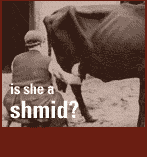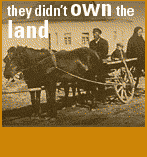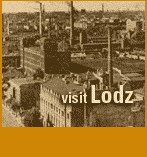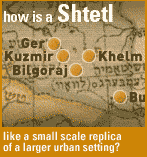

The Last Resort: Young Jews Choose Armed Resistance


Some of the first Jews to understand the scope of the Nazi plan for the mass murder of European Jewry were youth movement activists. They learned of the mass shootings of Jews in Eastern Europe in the autumn of 1941, including a report of the mass murder of Jews in Ponary near Vilna. The 23-year-old Abba Kovner  , a member of HaShomer HaTzair, concluded in December 1941 that Nazi policies were aimed at mass murder and therefore armed resistance was the only solution:
, a member of HaShomer HaTzair, concluded in December 1941 that Nazi policies were aimed at mass murder and therefore armed resistance was the only solution:
"Vilna is not just Vilna. The shootings at Ponary  are not just an episode...we are facing a well-planned system that is hidden from us at the moment. There is no rescue...Is there a way out? Rebellion and armed resistance. We are headed for absolute, total annihilation...Hitler intends to kill all the Jews...the Jews of Lithuania stand at the first place. Let us not go like sheep to the slaughter. We may be weak and defenseless but our only response to the enemy must be resistance."
are not just an episode...we are facing a well-planned system that is hidden from us at the moment. There is no rescue...Is there a way out? Rebellion and armed resistance. We are headed for absolute, total annihilation...Hitler intends to kill all the Jews...the Jews of Lithuania stand at the first place. Let us not go like sheep to the slaughter. We may be weak and defenseless but our only response to the enemy must be resistance."
Still, Kovner did not have any concrete proof that his assumptions were correct. It was difficult to convince others that armed resistance, which would surely result in the retaliatory murder of many, was the proper course. Despite the disbelief, the hostility of local populations, and the isolation faced by Jews cut off from other communities, Jewish youth active in Zionist  , Bundist
, Bundist  , and Communist youth movements came together in a number of places to resist the Nazis through armed conflict. The option of armed resistance was generally taken as a last resort, and only after the Jewish underground groups in various locations became convinced that the Nazis were bent on the total annihilation of the Jews. It was clear that fighting against such an overwhelming foe would not mean survival; it would mean a proud death, and to be remembered as defenders of the Jewish people. Jewish underground groups in ghettos, concentration camps and extermination camps, along with partisan groups in the forests, engaged in armed resistance in any way they could.
, and Communist youth movements came together in a number of places to resist the Nazis through armed conflict. The option of armed resistance was generally taken as a last resort, and only after the Jewish underground groups in various locations became convinced that the Nazis were bent on the total annihilation of the Jews. It was clear that fighting against such an overwhelming foe would not mean survival; it would mean a proud death, and to be remembered as defenders of the Jewish people. Jewish underground groups in ghettos, concentration camps and extermination camps, along with partisan groups in the forests, engaged in armed resistance in any way they could.
Uprisings
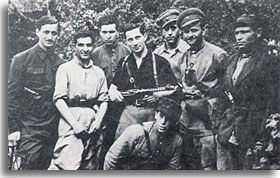

The most famous revolt took place in the Warsaw ghetto in April 1943. It was led by Mordecai Anilewicz  , Yitzhak Zuckerman, Josef Kaplan, Zivia Lubetkin, and others. The uprising lasted from April 19 to May 16, 1943. Abba Kovner attempted unsuccessfully to organize a revolt in the Vilna ghetto before the final deportations in September 1943. Facing opposition from the ghetto leadership and the majority of the ghetto population who refused to believe his dire predictions, Kovner led his band of fighters outside of the ghetto to fight the Nazis in partisan attacks in the forests. Uprisings also took place in Bialystok (August 16, 1943), Mir (August 9, 1942), Lachva (September 3, 1942), Kremenets (September 9, 1942), Czestochowa (October 25, 1943), Nesvizh (July 22, 1942), and Tarnow (September 1, 1943) when final deportations were announced.
, Yitzhak Zuckerman, Josef Kaplan, Zivia Lubetkin, and others. The uprising lasted from April 19 to May 16, 1943. Abba Kovner attempted unsuccessfully to organize a revolt in the Vilna ghetto before the final deportations in September 1943. Facing opposition from the ghetto leadership and the majority of the ghetto population who refused to believe his dire predictions, Kovner led his band of fighters outside of the ghetto to fight the Nazis in partisan attacks in the forests. Uprisings also took place in Bialystok (August 16, 1943), Mir (August 9, 1942), Lachva (September 3, 1942), Kremenets (September 9, 1942), Czestochowa (October 25, 1943), Nesvizh (July 22, 1942), and Tarnow (September 1, 1943) when final deportations were announced.
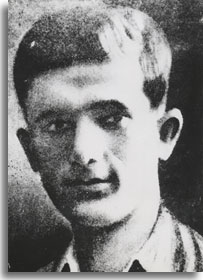

Despite almost impossibly difficult conditions, uprisings also occurred in death camps and concentrations camps. The most well known uprisings occurred in Treblinka in August 1943, Sobibor in October 1943, and Auschwitz in October 1944. Some Jews managed to escape from the camps, but such cases were rare, and those who were re-captured were executed. It is difficult to measure the impact of Jewish armed resistance efforts in terms of the number of German soldiers killed, or its effect on Nazi policy; in most cases, the practical results were negligible. The overall impact of armed Jewish resistance instead seems to have been much greater on the post-Holocaust consciousness of world Jewry.








